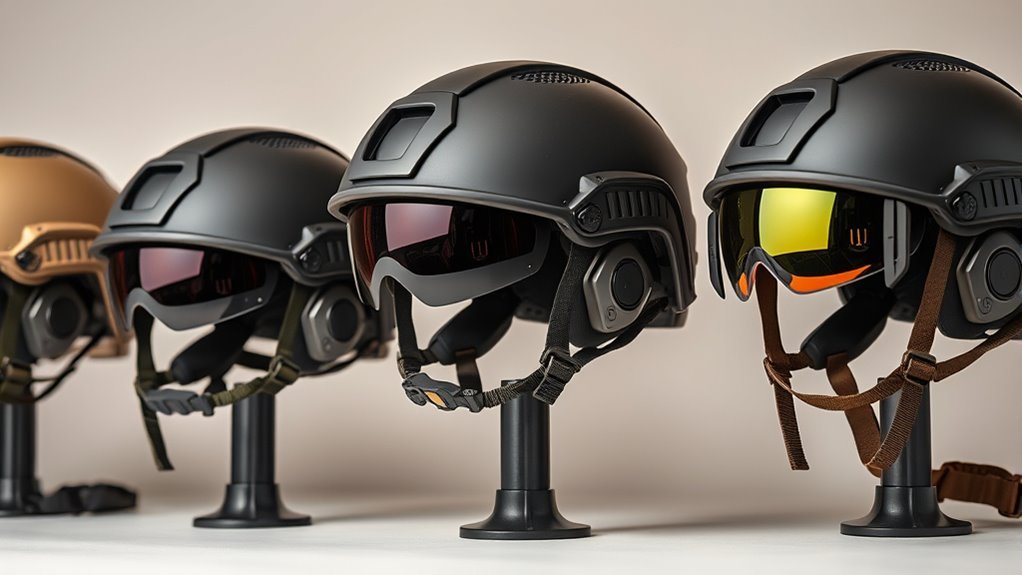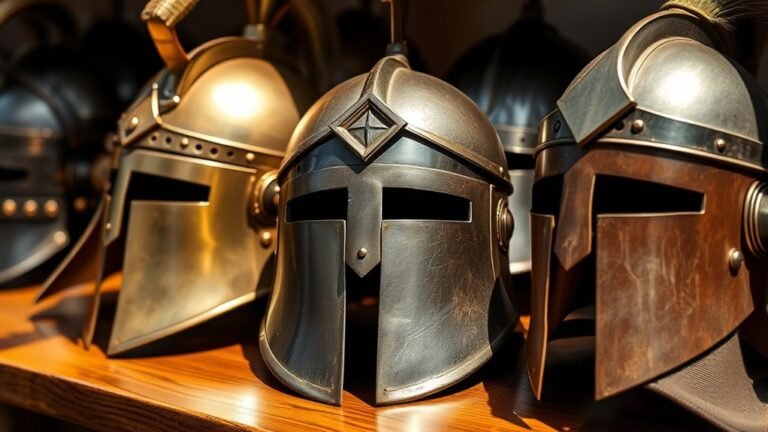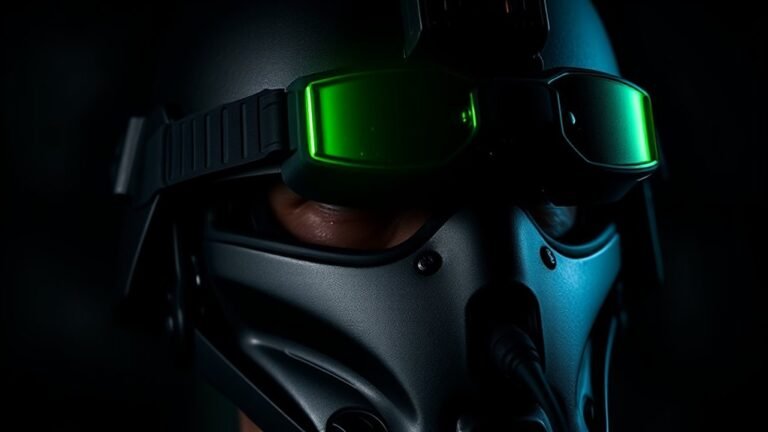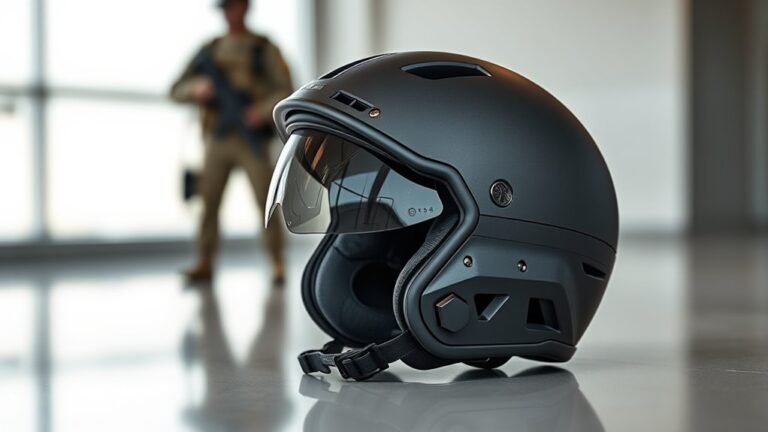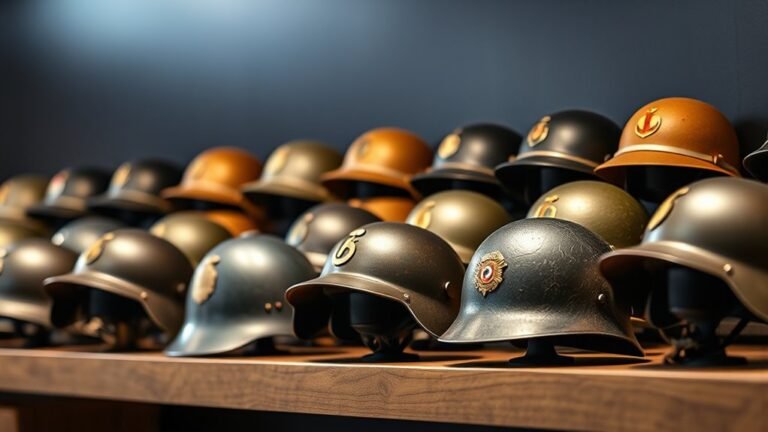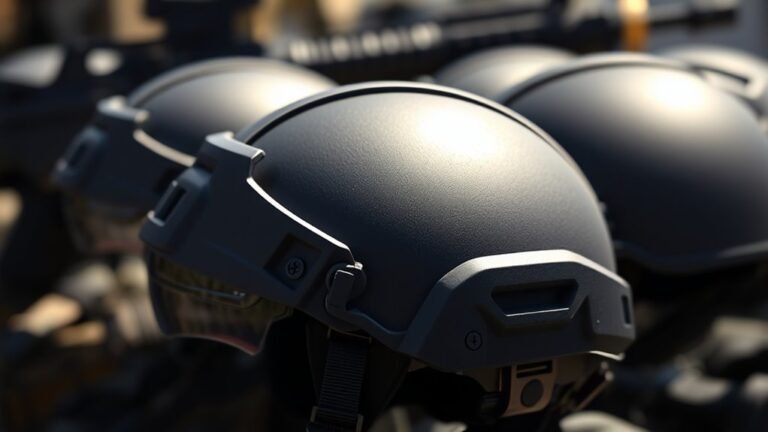Modern Combat Helmets and Their Features
Modern combat helmets combine advanced materials with innovative designs, prioritizing lightweight protection and comfort. They adhere to ballistic standards, ensuring safety against various weaponry. Integrated communication systems enhance situational awareness with real-time audio feedback and environmental sensors, detecting threats and environmental changes. Modular accessories allow for customization, adapting to mission needs. With promising future trends like smart textiles and augmented reality, these helmets are evolving. Discover more about the cutting-edge technologies and their benefits in today’s military landscape.
Evolution of Combat Helmets
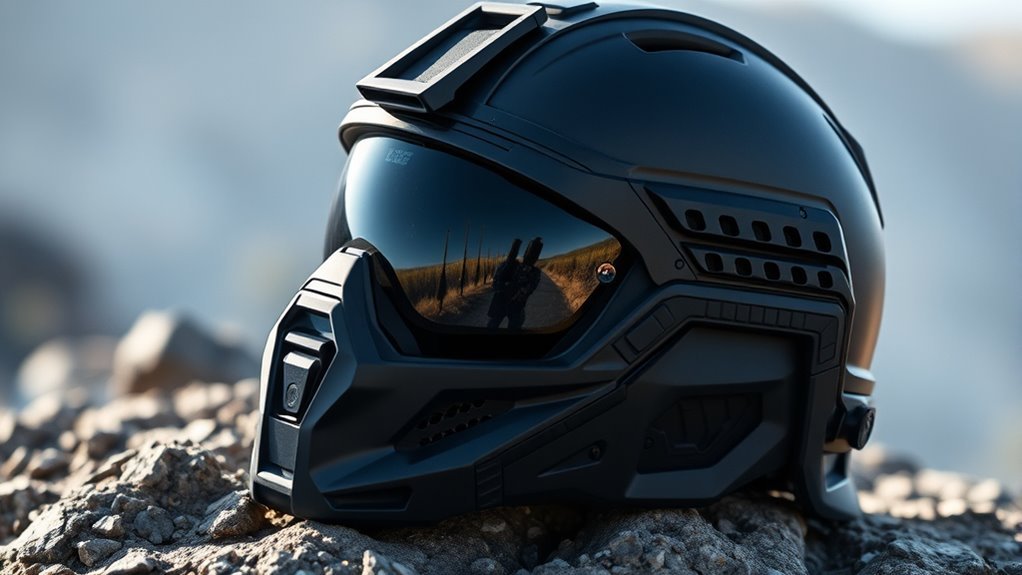
As the need for enhanced soldier protection grew, the evolution of combat helmets has been marked by notable technological advancements and material innovations. Historical designs, such as the steel helmets of World War I, were primarily focused on blunt force protection but lacked modern ballistic capabilities. Over time, materials evolution introduced lighter, more durable composites like Kevlar and carbon fiber, which greatly improved protection against shrapnel and projectiles. These advancements not only increased survivability but also enhanced comfort and mobility, allowing soldiers to maintain situational awareness. Modern helmets now integrate advanced features, such as mounting systems for communication devices and night vision, creating a versatile platform that supports operational effectiveness while safeguarding the freedom you value. This progression reflects a commitment to continuous improvement in soldier safety.
Ballistic Protection Standards
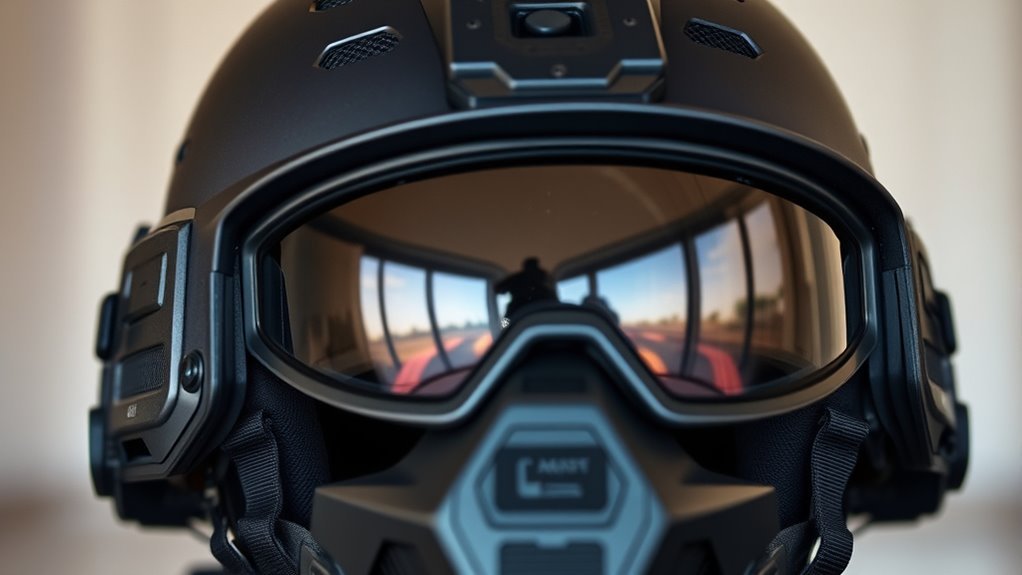
While advancements in helmet technology are impressive, understanding ballistic protection standards is crucial for ensuring that modern combat helmets meet the rigorous demands of today’s battlefield. These standards dictate the helmet’s ballistic rating, ensuring it can withstand specific threats.
| Protection Level | Ballistic Rating | Threat Type |
|---|---|---|
| Level I | 9mm FMJ | Handgun rounds |
| Level II | .357 Magnum | Medium handgun rounds |
| Level III | 7.62 NATO | Rifle rounds |
| Level IIIA | .44 Magnum | High-velocity rounds |
| Level IV | AP 7.62 NATO | Armor-piercing rounds |
Lightweight Materials and Design
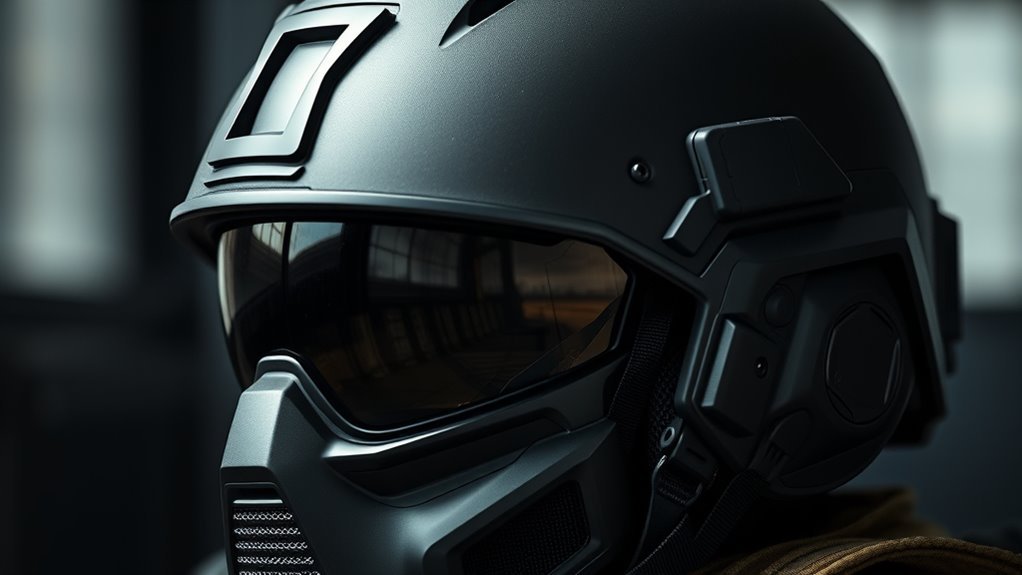
Modern combat helmets increasingly rely on lightweight materials and innovative designs to enhance soldier mobility without compromising protection. These advancements guarantee that you can maneuver freely while benefiting from robust impact resistance. Here are three key features:Modern combat helmets combine lightweight materials and innovative designs to enhance mobility while ensuring robust protection.
- Advanced composites – Utilizing materials like Kevlar and carbon fiber, these helmets provide superior strength while considerably reducing weight.
- Ergonomic design – Contoured shapes and adjustable fittings promote comfort features, allowing for extended wear without fatigue.
- Ventilation systems – Integrated airflow designs keep you cool and comfortable, even in high-stress environments.
Integrated Communication Systems
Integrated communication systems in modern combat helmets greatly enhance your situational awareness by providing real-time audio feedback and data connectivity. With advanced noise reduction technology, these systems filter out harmful sounds while allowing critical communications to come through clearly. Additionally, interoperability with various devices guarantees seamless integration, allowing you to coordinate effectively with your team in dynamic environments.
Enhanced Situational Awareness
As combat scenarios evolve, the necessity for enhanced situational awareness in military operations becomes increasingly critical. Modern combat helmets incorporate integrated communication systems that greatly improve your cognitive processing capabilities, allowing you to make informed decisions swiftly.
Consider these situational awareness techniques:
- Real-time data feeds: Receive live updates on troop movements and enemy positions directly through your helmet, keeping you informed.
- Multi-channel communication: Engage in clear conversations with team members while still perceiving ambient sounds, ensuring you’re attuned to your surroundings.
- Augmented reality displays: Visualize critical information layered onto your field of view, enhancing your tactical awareness without distraction.
These innovations empower you to navigate complex environments with heightened awareness, ultimately improving mission effectiveness and your safety.
Noise Reduction Technology
Combat helmets today often feature advanced noise reduction technology, which plays a crucial role in enhancing communication in chaotic environments. You’ll find that these helmets incorporate sophisticated noise cancellation methods designed to filter out harmful sounds while allowing critical audio cues to be heard. This guarantees you can maintain situational awareness amidst the clamor of combat. Hearing protection advancements have markedly improved the design of integrated communication systems, providing a seamless audio experience without compromising safety. By utilizing adaptive algorithms, these systems adjust in real-time to varying noise levels, guaranteeing peak performance. Ultimately, the integration of such technology empowers you to communicate effectively, preserving your freedom to make informed decisions in high-stakes situations while safeguarding your auditory health.
Interoperability With Devices
Modern combat helmets are engineered for seamless interoperability with various communication devices, ensuring that you stay connected in dynamic environments. By utilizing advanced interoperability protocols, these helmets enhance your situational awareness and coordination. You’ll appreciate the device compatibility that allows you to integrate:
- Tactical radios – enabling real-time voice communication with your team.
- Headset systems – ensuring clear audio transmission, even in high-noise scenarios.
- Data terminals – providing essential information and updates right in your line of sight.
This integration not only enhances operational efficiency but also empowers you with the freedom to respond swiftly in unpredictable situations. With modern helmets, connectivity means more than just communication; it’s about maximizing your effectiveness on the battlefield.
Enhanced Situational Awareness
Enhanced situational awareness in modern combat helmets relies on integrated communication systems, advanced vision technologies, and environmental awareness sensors. These components work together to provide real-time data, allowing you to make informed decisions under pressure. By leveraging these technologies, you gain a significant advantage in identifying threats and understanding your surroundings.
Integrated Communication Systems
Integrated communication systems in modern combat helmets play an essential role in enhancing situational awareness for military personnel. These systems integrate advanced communication protocols and user interfaces, allowing seamless interaction among team members. Here are three key features that elevate operational effectiveness:
- Real-time Voice Communication: Enables instant updates and coordination between squad members, minimizing response time.
- Data Sharing Capabilities: Facilitates the exchange of critical information, such as maps or tactical data, directly through the helmet interface.
- Environmental Sound Management: Balances ambient noise with communication inputs, ensuring you remain aware of your surroundings while staying connected.
Advanced Vision Technologies
The integration of advanced vision technologies into combat helmets greatly boosts situational awareness for military personnel. With systems like night vision, you can operate effectively in low-light conditions, enhancing visibility and reaction time. These technologies utilize infrared sensors to amplify ambient light, allowing you to spot potential threats that would otherwise remain hidden in darkness. Additionally, thermal imaging capabilities enable you to detect heat signatures, providing essential information about enemy positions and movements, even through smoke or foliage. This fusion of night vision and thermal imaging creates a thorough overview of your environment, empowering you to make informed decisions swiftly. By leveraging these advanced technologies, you gain a tactical advantage, ensuring both your safety and mission success in diverse combat scenarios.
Environmental Awareness Sensors
As you navigate complex environments, environmental awareness sensors play an essential role in enhancing your situational awareness on the battlefield. These advanced environmental sensors are critical for maintaining combat readiness, providing real-time data to keep you informed of your surroundings.
- Chemical Detection: Identifies airborne toxins, guaranteeing your safety in hazardous conditions.
- Temperature Monitoring: Alerts you to extreme weather changes, allowing for timely tactical adjustments.
- Acoustic Sensors: Captures sounds from various directions, helping you pinpoint enemy movements.
With this data, you’re empowered to make informed decisions, enhancing your operational effectiveness. These sensors not only bolster your situational awareness but also guarantee you remain agile and adaptable in ever-changing combat scenarios.
Modular Accessories and Customization
While modern combat helmets have evolved considerably regarding protection and comfort, their modular accessories and customization options are redefining how soldiers engage with their gear. Modular designs enable you to adapt your helmet quickly for various missions, enhancing versatility. You can integrate communication systems, night vision mounts, or ballistic visors tailored to your operational needs. Customizable features, such as adjustable padding and retention systems, allow you to achieve a personalized fit that maximizes comfort and stability during intense activities. This adaptability not only enhances performance but also empowers you to optimize your equipment for changing environments. Ultimately, the ability to modify your helmet fosters a sense of freedom, ensuring you’re equipped for any challenge that comes your way.
Environmental Adaptability
Given the diverse range of environments soldiers face, modern combat helmets are engineered for exceptional environmental adaptability. These helmets prioritize both climate resilience and terrain adaptability, ensuring you can operate effectively in any situation.
- Temperature Regulation: Advanced materials wick moisture and provide insulation, keeping you comfortable in extreme heat or cold.
- Waterproofing: Specialized coatings repel water, preventing damage and maintaining performance in wet conditions.
- Impact Resistance: Reinforced designs withstand harsh impacts from rocky terrains or urban environments, safeguarding your head.
These features not only enhance your safety but also empower you to focus on the mission. When you wear a modern combat helmet, you’re equipped to thrive in varied climates and challenging terrains, embodying the freedom to act without limitations.
Future Trends in Helmet Technology
With the rapid evolution of combat scenarios and technology, the future of helmet design is poised to integrate cutting-edge innovations that enhance both protection and functionality. You’ll likely see the incorporation of smart textiles, which offer adaptive responses to environmental stimuli, providing improved comfort and safety. These materials can regulate temperature and wick moisture, ensuring you stay focused during critical missions. Additionally, augmented reality (AR) features are set to revolutionize situational awareness, overlaying crucial information directly onto your field of vision. This technology can deliver real-time data, improving decision-making and tactical advantages. As these advancements take shape, you can expect helmets to become not just protective gear, but essential tools for modern warfare, merging safety with enhanced operational capabilities.
Frequently Asked Questions
How Do Modern Combat Helmets Affect Soldier Performance in the Field?
Modern combat helmets greatly streamline soldier performance in the field. By reducing cognitive load, they enhance situational awareness, allowing you to focus on mission-critical tasks. These helmets’ lightweight materials and integrated technology bolster battlefield safety and sensory perception, ensuring you remain agile and alert. With improved protection and communication capabilities, you can navigate complex environments more effectively, ultimately increasing operational efficiency and effectiveness. Gear up and stay sharp; every detail matters in combat.
What Maintenance Is Required for Modern Combat Helmets?
To maintain modern combat helmets, you should regularly perform helmet cleaning using mild soap and water, avoiding harsh chemicals that could degrade materials. After any impact, conduct an impact assessment to check for cracks or structural damage, as even minor impacts can compromise safety. It’s essential to store the helmet in a cool, dry place, ensuring it’s free from excessive heat or moisture, to prolong its lifespan and effectiveness in the field.
Are There Age Limits for Using Advanced Combat Helmets?
There aren’t strict age restrictions for using advanced combat helmets, but youth safety is essential. Manufacturers often recommend these helmets for individuals over a certain age, typically 18, due to the physical demands and potential risks involved. It’s vital to guarantee that younger users are physically and mentally prepared to handle military equipment. Always prioritize proper fit, weight, and comfort to maximize safety and effectiveness during use, regardless of age.
How Do Combat Helmets Integrate With Other Personal Protective Gear?
Combat helmets seamlessly integrate with other personal protective gear, forming a unified defense system. Think of it as a well-orchestrated symphony, where each piece—like body armor and communication devices—enhances your protective compatibility. This helmet integration guarantees that crucial features, such as night vision and hearing protection, work in harmony, allowing you to maintain situational awareness while staying safeguarded. It’s fundamental for maximizing your safety in high-risk environments, empowering your mission effectiveness.
What Is the Average Lifespan of a Modern Combat Helmet?
The average lifespan of a modern combat helmet typically ranges from five to ten years, depending on helmet durability and material technology. Advanced materials like Kevlar and carbon fiber enhance protection but may degrade over time due to environmental factors or impact. Regular inspections are essential to guarantee performance, as exposure to extreme conditions can compromise structural integrity. You should always replace your helmet if it shows signs of wear or after significant impacts.
